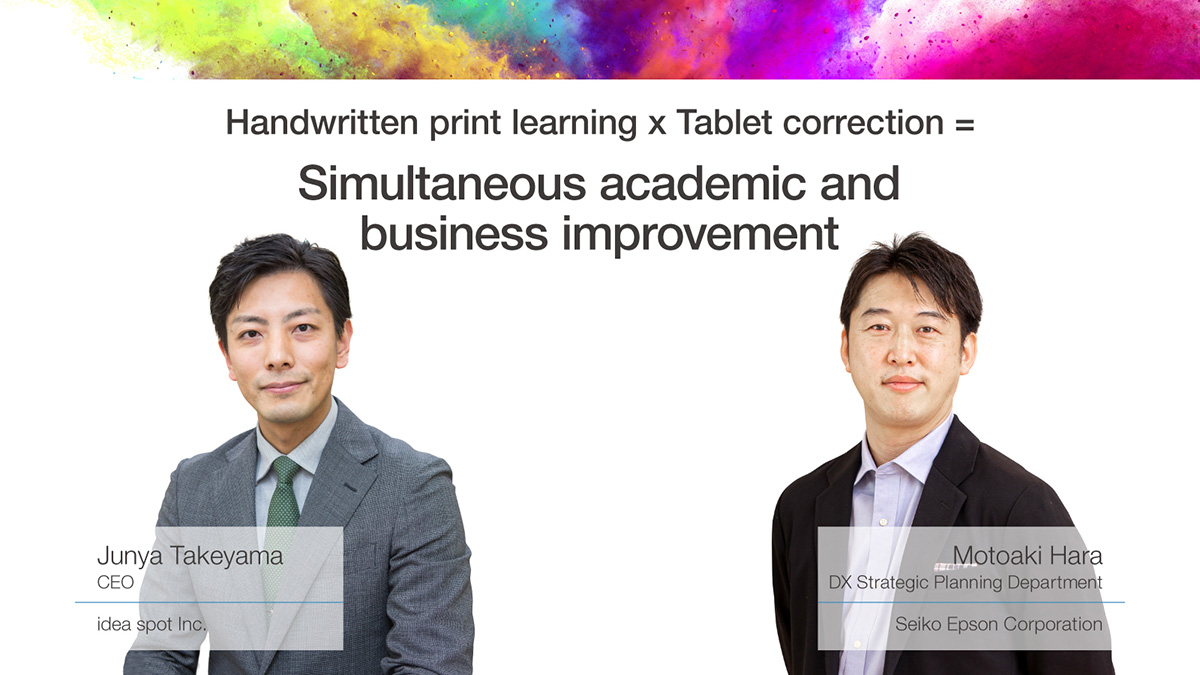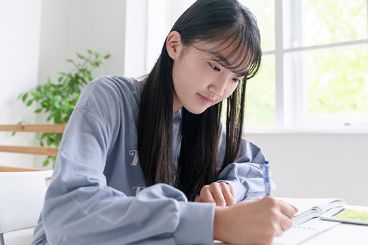What we can do for children-Innovation in the field of education

In this dialog, Motoaki Hara, who is in charge of the field of education at DX Strategic Planning Department, Seiko Epson Corporation spoke online with Junya Takeyama, CEO of idea spot Inc., who introduced a learning support service using Epson Connect's Mail de Remote Printing and Scan to Cloud functions. They discuss the current state of DX promotion in the field of education and the outlook for the future while looking back on the exchanges they had during the introduction of the service.
Mr. Junya Takeyama
CEO of idea spot Inc.
Motoaki Hara
DX Strategic Planning Department, Seiko Epson Corporation
* In the text, honorifics are omitted.
Hara:
When we first established the DX Strategic Planning Department, I was the only one in charge of the education field. Now, about a year later, I hear words like "education," "school," and "cram school" daily from both top management and sales. Expectations within the company are higher than I'd expected, and recently I've started to feel a little scared.

Takeyama:
I think this is an area that many people are interested in. In this case study of idea spot, the system's role as a supplement to the online education that was suddenly in use due to the coronavirus outbreak, but there were also other situations where I felt there were many possibilities. For example, when Mr. Hara told me that we could send printed material to Africa, I immediately thought about supporting children and their families living abroad who plan to return to Japan in the near future. We believe that this will have a significant impact, especially in countries and regions with a large time zone difference from Japan.
Hara:
It seems to me that corrective guidance using printouts to reinforce weak points would certainly not be affected by differences in time zone and would allow for careful, individually optimized guidance.
Takeyama:
It's worth mentioning that under the current junior high school examination system, there are many places where the qualification for taking the examination for returnees is technically within 2 to 3 years of returning to Japan. This means children who have lived abroad for many years and returned to Japan by the third grade of elementary school will face a significant handicap. In the past, I've heard of parents giving up on overseas assignments for the sake of their children's future, and I've wondered if there's anything we could do about that. I imagined that if we could address this problem using the Epson Connect learning support service, it would help us expand our sales channels as well as let idea spot encourage Japan's brilliant minds to go abroad and play an active role.
Hara:
In our company, we often talk about how we can use our technology and services to help reduce educational disparities. For example, I think we can all agree that there is now a disparity in education depending on where you live. At the DX Innovation Lab Aizu in Aizuwakamatsu, Fukushima Prefecture, we are currently conducting a demonstration experiment of remote education, using our projectors to connect remote classrooms as if they were one space, with the aim of securing educational opportunities in depopulated areas. If the internet connection is good, the quality is already quite immersive. If we can combine this with our service using our printers and scanners, I think the range of learning opportunities will expand even further.

Takeyama:
It's something like the remote hot spring in the recent canned coffee TV commercial. I mentioned overseas earlier, but even now, I often receive requests from areas outside Kyoto to receive instruction using idea spot's printed materials. It's not uncommon in both public education and private education for students not to get the learning opportunities they seek, and I would like to see this happen.
Hara:
As well as the learning support service that you introduced and the case study in Aizuwakamatsu that I just mentioned, we're also focused on providing services and products that could help teachers improve their work. This includes Epson CoCo-Creator, which supports the creation of school newsletters. What do you think are the education industry's needs?
Takeyama:
Cram schools are no stranger to the changes in the way educators work. At idea spot, we had a situation previously where the workload was concentrated on one excellent teacher, and that's why I believe that ICT should be used to supplement what is being done. For example, AI and robots are far better at things like log analysis, and there's no need for people to expend their energies doing that. I don't think we should leave it to AI to interpret those results though. For example, even if the AI claims to have proposed the best solution for each individual, it is difficult to trust that proposal if you don't understand what that decision was based on. To put it more concretely, it's quite common for an AI to say that the reason you got a particular math problem wrong was that you had a problem with your math work up to that point. Still, when you look into the real cause, you find that the problem was actually a faulty interpretation of the question's language. This kind of story is quite common. We should all keep in mind that not everything can be improved by introducing technology; reading children's expressions in class, for example, is one area where humans are still better.
Hara:
Are there any considerations you have to take into account when you’re implementing the service or promoting DX in the education industry?
Takeyama:
I think what we need to do is separate the two, that there are parts that should be left to people and parts that should be left to technology. I feel that we are trying to leave some parts to technology that shouldn't be. I think that could be an issue for the future. The other thing I remember from when the service was introduced is the detailed manual that Mr. Hara created for our case study, which was very helpful. When promoting DX in the education industry, we tend to focus on children and parents, when in fact, people often say it's more challenging to overcome teachers' psychological barriers. I think it's necessary to pay attention to teachers' comfort levels, to improving their ability, and careful preparation.

Hara:
Naturally, I use printers and scanners as a matter of course, but as a device intended to be used by a sixth-grader who had never touched a printer before, I didn't honestly think the user interface was very good. I'm sure I'll get some pushback at work for saying this, but as a result, we've tried to make a manual that anyone can use. Speaking of meaningful communication, we've continued to meet with you once a month since the introduction. Rather than just listening to your requests, we've spent a lot of time working together to develop solutions. I've also learned a lot about how to actually use the services we provide and the possibilities they offer. Since they agreed to work with us, we've followed almost all of the logs, and it was a valuable opportunity for us to realize that we were missing a lot of functionality, not only in the UI.
Takeyama:
An accumulation of dialogue seems to have been the secret to both our success. In that sense, as you promote DX in the education industry into the future, what I would like is to see you strengthen the collaboration between schools and cram schools. Nowadays, people say there's a wave of DX promotion in school education, and if it is implemented, the role of cram schools will naturally change to complement school education. If we have a system that allows us to share information directly, we should be able to provide education that benefits children even more than now, making the most of each other's strengths and areas of expertise. This is a delicate area, but I hope that we can make this happen.

Hara:
It is true that until now, when we talked about this kind of thing, we seemed to stop at the point where the client said, "We've never tried it successfully." We in the DX Strategic Planning Department are currently focusing our activities on open innovation precisely because of the same awareness of the problem as you. We believe that educational resources and children's learning logs are not something that anyone should control. That goes for schools, for manufacturers like us, for digital platform providers, for everyone. I think it's more important than ever that we look beyond our own interests.
Takeyama:
Even if we look only at the domestic market, there are different government agencies with various jurisdictions. This makes it necessary to coordinate across government ministries, such as the Ministry of Economy, Trade, and Industry and the Ministry of Education, Culture, Sports, Science, and Technology. This is an area where it's difficult for a private school owner like us to make any impact, but it's reassuring to have a company like Epson, whose mission is to contribute to creating a better society, working with us on it.
Hara:
It’s a tall order, but we'll do our best. Since I started approaching the field of education this time, I've felt blessed to have connections with people, and of course, you’re one of them. I've come to believe that in the end, it's the power of people who think seriously about what they can do for children that makes the education industry tick. I want to continue to think about the DX strategy without being distracted by the industry's barriers and always maintaining the perspective of what we can do for children.
*For more about Epson Connect: http://www.epsonconnect.com/
*For more about Epson CoCo-Creator: https://www.epson.jp/products/bizprinter/smartcharge/academic/coco/
(Japanese only)
Interview : January 2021
Written interview content and names of organization, affiliations, and titles, etc. are as of the time of the interview.



